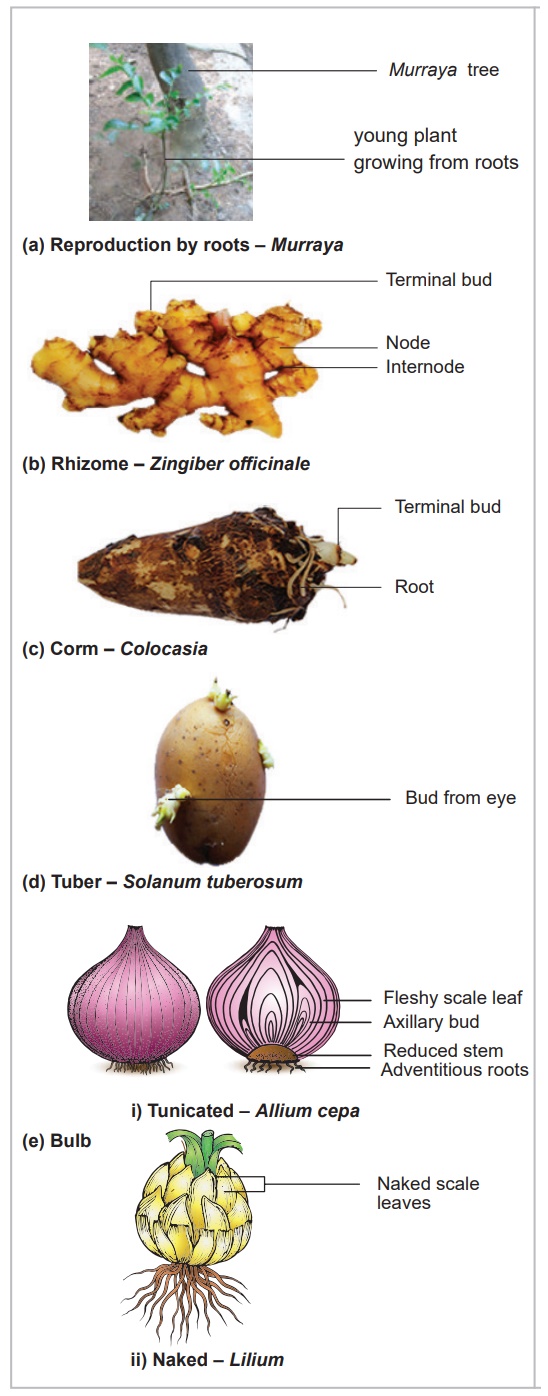Vegetative reproduction in Plants - Natural Vegetative methods | 12th Botany : Chapter 1 : Asexual and Sexual Reproduction in Plants
Chapter: 12th Botany : Chapter 1 : Asexual and Sexual Reproduction in Plants
Natural Vegetative methods
Vegetative
reproduction
Natural methods
Natural vegetative
reproduction is a form of asexual reproduction in which a bud grows and
develops into a new plant. The buds may be formed in organs such as root, stem
and leaf. At some stage, the new plant gets detached from the parent plant and
starts to develop into a new plant. Some of the organs involved in the
vegetative reproduction also serve as the organs of storage and perennation.
The unit of reproductive structure used in propagation is called reproductive
propagules or diaspores. Some of the organs that help in vegetative
reproduction are given in Figure 1.1.
A. Vegetative reproduction in root
The roots of some plants
develop vegetative or adventitious buds on them. Example Murraya, Dalbergia
and Millingtonia. Some tuberous adventitious roots apart from
developing buds also store food. Example Ipomoea batatus and Dahlia.
Roots possessing buds become detached from the parent plant and grow into
independent plant under suitable condition.
B. Vegetative reproduction in stem
From the Unit 3 of class
XI (Vegetative morphology) you are familiar with the structure of various
underground stem and sub aerial stem modifications. These include rhizome (Musa
paradisiaca, Zingiber officinale and Curcuma longa); corm
(Amorphophallus and Colocasia); tuber (Solanum
tuberosum); bulb(Allium cepa and Lillium) runner (Centella
asiatica); stolon (Mentha, and Fragaria); offset (Pistia, and Eichhornia);
sucker (Chrysanthemum) and bulbils (Dioscorea and Agave).
The axillary buds from the nodes of rhizome and eyes of tuber give rise to new
plants.
C. Vegetative reproduction in leaf
In some plants
adventitious buds are developed on their leaves. When they are detached from
the parent plant they grow into new individual plants. Examples: Bryophyllum,
Scilla, and Begonia. In Bryophyllum, the leaf is
succulent and notched on its margin. Adventious buds develop at these notches
and are called epiphyllous buds. They develop into new plants forming a
root system and become independent plants when the leaf gets decayed. Scilla
is a bulbous plant and grows in sandy soils. The foliage leaves are long and
narrow and epiphyllous buds develop at their tips. These buds develop into new
plants when they touch the soil.
Advantages of natural vegetative reproduction
·
Only one parent is required for propagation.
·
The new individual plants produced are genetically identical.
·
In some plants, this enables to spread rapidly. Example: Spinifex
·
Horticulturists and farmers utilize these organs of natural
vegetative reproduction for cultivation and to harvest plants in large scale.
Disadvantage of natural vegetative reproduction
New plants produced have
no genetic variation.


Related Topics